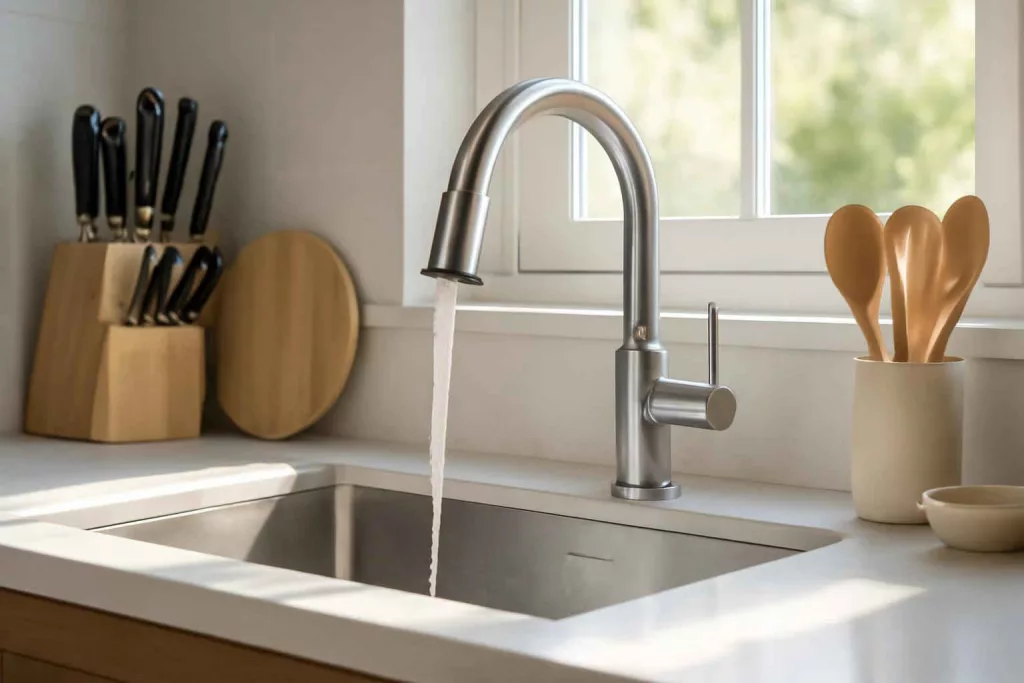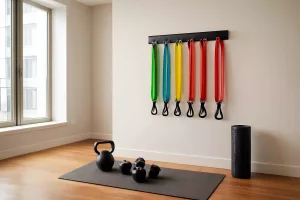Upgrading to a touchless kitchen faucet can transform your cooking space into a more hygienic, efficient, and modern environment. With just a wave of your hand, you can control water flow without ever touching the handle, minimizing cross-contamination and making daily tasks simpler. In this comprehensive guide, we’ll dive into the benefits of a hands-free kitchen faucet, help you identify key features to look for, and walk you through installation and maintenance best practices. Ready to make the switch? Check out the latest sensor faucets on Amazon for a hands-free solution that fits your needs: touchless kitchen faucet options.
Why Choose a Touchless Kitchen Faucet?
Kitchen sinks are high-traffic zones where germs and bacteria can quickly spread. Traditional faucets require direct contact, which means your hands—often coated with raw meat juices, flour, or other contaminants—transmit those germs to the handle and then to the next user. With an automatic sensor faucet, water flow activates the moment your hands pass beneath the spout, allowing you to rinse, wash hands, or fill pots while keeping contamination at bay.
Beyond cleanliness, many homeowners appreciate the water-saving potential of touchless designs. Sensor-activated faucets shut off automatically when not in use, which can reduce wasted water by up to 30% compared to manual models. For families focused on sustainability and lower utility bills, this feature alone can justify the investment. Plus, modern sensor faucets often include adjustable flow rates and temperature controls, giving you full command over your kitchen sink experience.
If you’re concerned about installation complexity, rest assured that most touchless faucets fit standard sink configurations and come with detailed instructions. In fact, you can streamline your under-sink layout by combining your faucet installation with other enhancements, like adding under-sink water softener systems to protect your fixtures from mineral buildup. Once installed, these faucets deliver a seamless, almost futuristic experience that elevates everyday tasks.
Key Features to Look For in Sensor Faucets
Selecting the right touchless kitchen faucet means balancing convenience with performance and durability. Below are the critical attributes to evaluate before making your purchase:
Sensor Accuracy and Range
Accuracy determines how quickly and reliably the faucet responds to your presence. Look for models with selectable sensor ranges—from a few inches up to six inches—so you can adjust sensitivity based on sink depth and ambient reflections. A well-tuned sensor minimizes false triggers and ensures water only flows when you intend. Advanced infrared or capacitive sensors typically outperform basic photoelectric designs, offering smoother activation and fewer nuisance cycles.
Water Flow and Temperature Control
Nothing ruins the touchless experience more than unexpected bursts of cold or scalding hot water. Seek faucets with separate temperature levers or remote handles that allow fine-tuned adjustments. Some high-end models even offer preset temperature locks, so you can program a comfortable rinse setting and never worry about accidental scalds. Pay attention to the gallons-per-minute (GPM) rating; a flow rate between 1.5 and 2.2 GPM delivers a strong stream without sacrificing efficiency or running afoul of water-conservation regulations.
Installation and Compatibility
Most sensor faucets require a nearby power source—either battery-operated (AA or AAA batteries) or a 110V adapter. Battery-powered units are easier to install but need periodic battery changes, while plug-in models ensure uninterrupted operation if you have an outlet under your sink. Check that the faucet deck plate matches your sink’s hole configuration (single-hole, three-hole centerset, or widespread) to avoid extra drilling. If you’ve already optimized your under-sink storage, consider complementing your setup with dedicated under-sink pull-out cabinet organizers to keep batteries, adapters, and cleaning supplies neatly accessible.
Durability and Finish
Kitchen faucets endure daily wear and tear, so prioritize materials like solid brass construction, stainless steel spouts, and ceramic disc cartridges for leak-free performance. Finishes such as brushed nickel, matte black, and polished chrome resist corrosion, fingerprints, and water spots. Look for faucets with at least a one-year manufacturer’s warranty on electronics and parts, plus a limited lifetime warranty on finishes. This reassures you that your investment is protected against early wear.
Top 5 Touchless Kitchen Faucets for Hands-Free Convenience
Our research team evaluated dozens of sensor faucets based on user reviews, lab tests, and value for money. Below are our top picks that excel in quality, reliability, and features.
-
Moen Arbor Touchless Stainless Steel Faucet
Equipped with Reflex™ technology for smooth docking and an intuitive motion-free Wave sensor, the Moen Arbor offers a 1.5 GPM flow, dual-function sprayer, and optional power adapter. The clean, transitional design blends seamlessly with modern and traditional kitchens. Buy on Amazon -
Delta Faucet Foundations Touch2O
Delta’s Touch2O technology features a spot-resistant stainless finish, magnetic docking spray head, and a 2.2 GPM flow. Users praise its consistent sensor performance and easy-to-replace batteries. The ADA-compliant design fits a standard single-hole sink. Buy on Amazon -
Kohler Sensate VoiceIQ Faucet
Integrating with voice assistants, the Kohler Sensate VoiceIQ allows hands-free voice commands for flow rate, temperature, and timer functions. The pull-down spray head and premium ceramic valve ensure long-lasting reliability. Recommended for tech-forward households. Buy on Amazon -
American Standard Colony Soft Touchless Faucet
This budget-friendly option features a motion-sensitive sensor, 1.8 GPM flow, and a durable stainless body. Ideal for rental units or secondary kitchen areas. Installation requires two AAA batteries, with LED battery indicators built into the base. Buy on Amazon -
Pfister Lita Smart Sensor Faucet
Pfister’s Lita series offers a high arc spout, touchscreen temperature control, and a reliable infrared sensor. The 1.5 GPM nozzle reduces splash, while the matte black finish hides fingerprints. Backed by Pfister’s Pforever warranty. Buy on Amazon
Installation Guide: Best Practices for Sensor Faucet Setup
Installing a touchless kitchen faucet is typically a straightforward process that DIY enthusiasts can tackle in an afternoon. Before you begin, gather basic plumbing tools—an adjustable wrench, plumber’s tape, and a basin wrench—and ensure your water supply lines are compatible with the faucet’s fittings. Most sensor faucets come with detailed instructions, but these best practices will help you avoid common pitfalls:
- Turn Off Water Supply: Always shut off both hot and cold water valves under the sink before disconnecting any lines.
- Test Sensor Functionality Before Mounting: Connect the sensor control box, insert batteries or plug in the adapter, and test the activation range. Adjust sensor sensitivity per the manufacturer’s guidelines.
- Seal Connections Properly: Use plumber’s tape on threaded joints to prevent leaks, especially when connecting the sensor control box to the water lines.
- Check for Clearance and Alignment: Confirm that the faucet spout clears any overhanging shelves or window sills and that the sensor is aimed toward the sink basin for optimal performance.
- Coordinate Under-Sink Layout: Keep the power adapter or battery pack accessible. Supplementary storage like silicone drawer liners or stackable bins can help you organize tools and spare parts neatly.
Once installed, gently run water through the system, inspect for leaks, and fine-tune the temperature handle. Take advantage of manufacturer presets or memory functions to lock in a comfortable water temperature that works for all family members.
Maintenance Tips to Keep Your Sensor Faucet Running Smoothly
Routine maintenance ensures your touchless kitchen faucet remains reliable for years to come. Follow these simple steps every few months:
- Clean the Sensor Window: Wipe the sensor area with a soft, damp cloth to remove grease, soap residue, and hard-water deposits that could impair detection accuracy.
- Flush the Aerator: Mineral buildup can restrict flow. Unscrew the aerator, soak it in vinegar for 30 minutes, rinse thoroughly, and reinstall.
- Inspect Battery or Power Adapter: For battery-powered units, replace batteries once the low-battery indicator illuminates. For plug-in models, check the power cord for signs of wear.
- Check Fittings and Hoses: Under the sink, visually inspect connections for drips. Tighten fittings as needed and reapply plumber’s tape on any threaded areas showing moisture.
Implementing these simple maintenance routines can prevent common issues such as erratic sensor behavior or reduced water pressure. If you experience persistent problems, consult the manufacturer’s troubleshooting guide before considering replacement parts.
How a Touchless Faucet Improves Hygiene and Efficiency
Hands-free faucets significantly reduce bacterial transfer in the kitchen. By eliminating the need to touch handles after handling raw ingredients, you maintain a cleaner sink area throughout meal prep. Studies show that sensor faucets can lower surface germ counts by up to 50% compared to manual counterparts.
Beyond cleanliness, automatic faucets offer precise water control where you need it most. Fill pots without adjusting handles, pause flow mid-task while retaining your temperature settings, and reduce wasted water when rinsing produce or washing hands. Over time, these small efficiencies add up—saving gallons of water per household annually.
Many homeowners also find that upgrading to a touchless model enhances the overall aesthetic of their kitchen. Sleek lines, polished finishes, and concealed electronics create a minimalist look that pairs well with modern cabinetry and countertops. In rental properties or shared living spaces, touchless faucets can even increase perceived property value by showcasing attention to detail and advanced features.
Conclusion
Investing in a touchless kitchen faucet is more than just a design upgrade—it’s a commitment to healthier habits, water conservation, and modern convenience. From sensor accuracy to ease of installation and ongoing maintenance, choosing the right model ensures you enjoy years of hands-free performance. Explore our top picks, follow the installation best practices, and maintain your faucet with simple cleaning routines to get the most out of this transformative kitchen upgrade. Ready to experience a germ-free sink space? Check out the full range of sensor faucets on Amazon and find the perfect fit for your home: shop touchless kitchen faucets.






